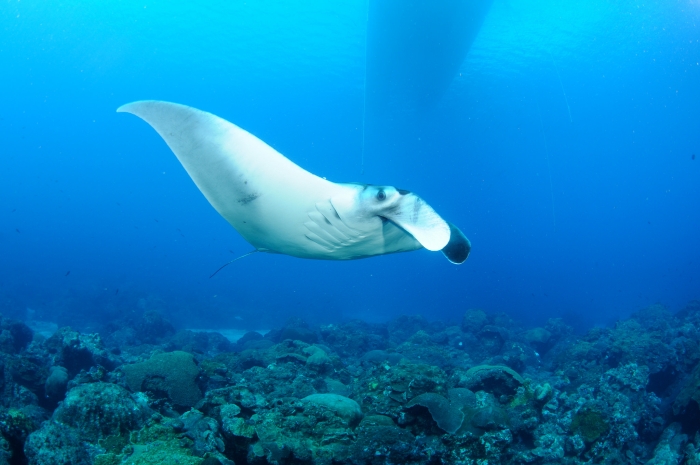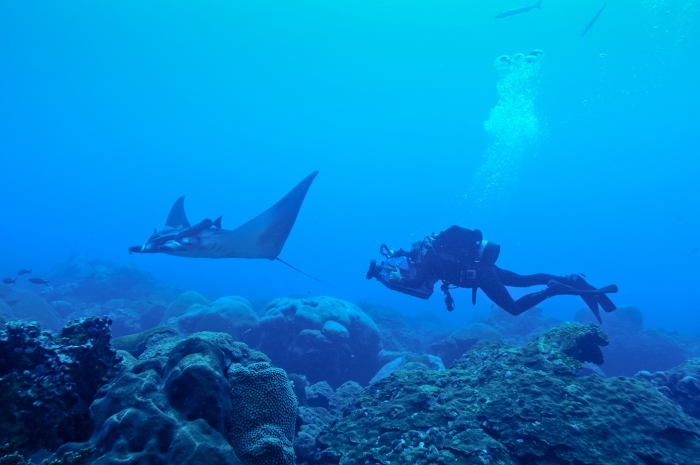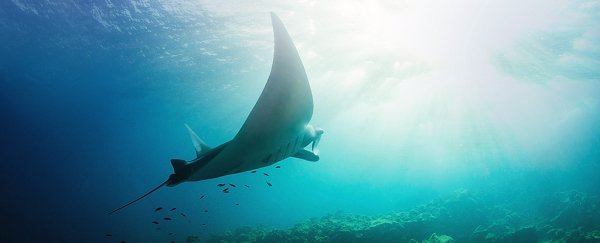The mystery of where manta rays keep their babies has started to unravel, with new data describing a rarely seen manta ray nursery.
It's off the coast of Texas, in the NOAA's Flower Garden Banks National Marine Sanctuary in the Gulf of Mexico, where marine scientists have observed unprecedented numbers of juvenile manta rays.
The area was first described as a potential manta ray nursery in 2001. Since manta ray pups are rarely seen in the wild, the new data is tremendously exciting.
"The juvenile life stage for oceanic mantas has been a bit of a black box for us, since we're so rarely able to observe them," said marine biologist Joshua Stewart of Scripps Institution of Oceanography.
"Identifying this area as a nursery highlights its importance for conservation and management, but it also gives us the opportunity to focus on the juveniles and learn about them."
 (Scripps Institution of Oceanography)
(Scripps Institution of Oceanography)
Manta rays - the largest rays in the world - are known as "gentle giants" for their peaceful ways. They are filter feeders who mainly eat plankton, and they grow enormous - with a wingspan of up to 7 metres (23 feet) across, and reaching weights of up to 2,400 kilograms (around 5,291 pounds).
They're also very slow procreators. With a lifespan of about 40 years, these animals reach sexual maturity at about the age of 10. Gestation takes somewhere between 10 and 14 months, after which the female give live birth to just one pup.
It's thought that manta rays have one baby every 2 to 3 years, giving them an extraordinarily low fecundity rate compared to other cartilaginous fish.
This means that their young are very valuable indeed, so it stands to reason that they'd be sequestered somewhere safe while the rest of the squadron swims the open seas. However, known aggregation sites are usually far from coastal areas, which makes these fish hard to study - and juveniles are almost completely absent from manta ray populations.
In 2015, researchers found the world's first confirmed manta ray nursery in a sanctuary off the coast of Indonesia. GPS tags on pregnant and young manta rays revealed that Wayag Lagoon in Raja Ampat is used by manta rays as a nursery and pupping ground.
However, the Flower Garden Banks nursery is the first to be described in a scientific paper.
 (Scripps Institution of Oceanography)
(Scripps Institution of Oceanography)
The researchers realised the importance of the site after Stewart observed several juveniles swimming in the area. After looking through 25 years' worth of dive log and photo identification data - manta rays have spots on their undersides that are as individual as fingerprints - the research team realised that 95 percent of the manta rays visiting the area were juveniles.
The findings could be important for manta ray conservation. Both of the existing manta species - Manta alfredi and M. birostris - are listed as vulnerable on the IUCN Red List, and fishing catch data have revealed dramatic declines in numbers.
They're also under threat by the gill raker trade, which fishes rays for their gill rakers for use in Chinese medicine.
The researchers don't know why the rays chose the area they did, but figuring it out could help identify similar places in the world's oceans, and therefore hopefully locate more nurseries. This, in turn, could expand our knowledge about the strange and beautiful fish - and, more importantly, help protect these areas from human threats.
"There's so much we don't know about mantas and that's exciting from a science perspective because it means there are so many questions still waiting to be answered," said Stewart.
"This discovery is a major advancement in our understanding of the species and the importance of different habitats throughout their lives."

The team's research has been published in the journal Marine Biology.
Editor's note (27 Jun 2019): This article has been updated to reflect corrections issued for the original paper, which you can find here.
